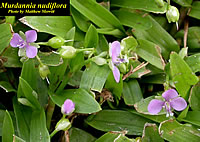Phytochemical Standardization and Analgesic Activity of Murdannia nudiflora (L) Brenan
Our present communication deals with physicochemical parameters, preliminary phytochemical studies and pharmacological impact of Murdannia nudiflora (L) Brenan as analgesic plant which is used in folklore uses of Assam. No reports are available on standardization parameters hence, the present attempt was undertaken to investigate the standardization parameters to establish its authenticity. The study revealed the presence of wide range of phytoconstituents. The determination of these characters will aid future investigators in their Pharmacological analysis of this species.
The whole 8 pages article is available for download here.
The history of herbal medicines is as old as human civilization. Almost one fourth of pharmaceutical drugs are derived from botanicals. The World Health Organization (WHO) estimates that 80% of the world’s population presently uses herbal medicine for some aspect of primary health care. Murdannia nudiflora (L) Brenan is a herb belonging to family Commelinaceae. It is a slender, nearly smooth, creeping annual or perennial herb. The stem is simple to branched 15-30 cm long, reclining on the ground with rooting at the nodes. The roots are fibrous. The leaves are rather thick, linear to linear oblong, alternate, narrowed into a base sheath, entire, acute, tapering to a point with sides incurved, measuring 3-10 cm long and 4-10 mm wide. Widely distributed in India; found in wet places, paddy fields, marshes, along ditches and in shady, grassy places, an aggressive weed in parts of West Indies; Stems decumbent below and ascending above, branch lets reddish with white nodes, flowers clustered in terminal or axillary cymes, blue or pinkish. Used locally in the treatment of asthma, leprosy and piles stomach complaints, giddiness, and astringent. Root paste with goat milk is prescribed orally to cure asthma. Whole plant paste with common salt is applied on the affected area to cure leprosy.
The present investigation deals with the study of some physicochemical characteristic and its establishment as analgesic plant.
The whole 8 pages article is available for download here.

